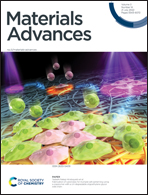A case of perfect convergence of light and heavy hole valence bands in SnTe: the role of Ge and Zn co-dopants
Abstract
A dual step approach of decreasing the thermal conductivity and improving the power factor by using two different dopants has shown great promise in the development of high performance thermoelectrics. In this work, we dope Ge, which is well known to decrease the thermal conductivity of SnTe. Later, to this, we co-dope Zn to simultaneously improve the power factor. Zn, in the presence of Ge, introduces resonance levels, thus distorting the density of states near the Fermi level, improving the room temperature performance. In addition, it is also able to increase the band gap, thus preventing bipolar diffusion at high temperatures. The unique feature exhibited is the perfect convergence of light and heavy hole valence sub-bands achieved for the first time in SnTe promising a high performance throughout the temperature range. The transport property calculations reveal that in addition to p-type, it can also act as an outstanding n-type material by tuning its chemical potential, making it worth studying experimentally.

- This article is part of the themed collection: Celebrating International Women’s Day: Women in Materials Science


 Please wait while we load your content...
Please wait while we load your content...